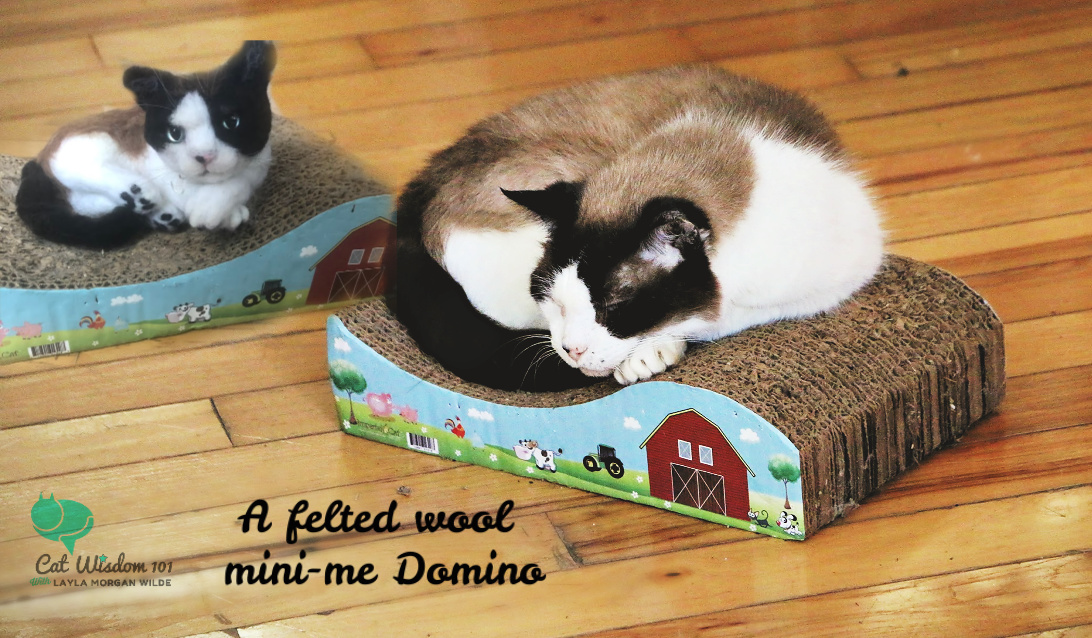
VET 101: Leaves Of Three, Let Them Be
We’ve had an early spring in the North East with lush gardens but not all greenery is welcome. Poison ivy and oak has already been spotted and is the subject for this week’s Q & A with our vet, Dr. Rich Goldstein or as I like to refer to him, Gr. G. The image above (taken from my garden) is thankfully poison ivy-free, for now.
Update with more poison ivy tips
Q: I have an itchy rash on my ankles that my doctor says is poison ivy. My cats go outdoors but we have no poison ivy in our yard to my knowledge. Now I’m worried the cats will bring it back again and are they at risk for itchy rashes?
A: “Leaves of three, let it be.” Funny how some sayings from childhood stick with you.
Poison Ivy, poison oak, and poison sumac all have a sap in their roots containing an ingredient called urushiol. When the plant is bruised, the sap is deposited on the skin (or fur, or clothing, or shoes), causing an allergic reaction in about 80% of people exposed to it. (Fun fact: 500 people could start itching from the amount of urushiol that could fit on the head of a pin!) Interestingly, just brushing up against an intact plant would not cause the allergic reaction. But in the spring and summer, the leaves and stems of the plants are very fragile and break easily, which is why contracting “poison ivy” is more common at this time of year.
Cats, as a species, tend to be relative resistant to “contact dermatitis”, and don’t usually suffer the same allergic reactions to the urushiol as people. But they can certainly transmit the sap to people just through contact with contaminated fur. (If your cats truly were the culprits here, it would be unusual for you to just get a reaction on your ankles, and not on your hands, but anything’s possible.)
So here are some suggestions for limiting your risk:
- When the cats come back into the house, try wiping them down with pet wipes to remove any of the sap that may have gotten on their fur during their travels. If you’re sensitive to the sap, wear disposable gloves, and avoid exposing other body parts to the fur. It has been reported that urushiol oil can stay active on any surface for up to 5 years.
- It takes approximately 15 minutes for the sap to elicit an allergic reaction on human skin. So, if you think (or know) you’ve been exposed, washing the exposed body parts in warm soapy water may prevent or lessen the reaction. Once the sap has latched on to the skin cells, the rash can last for up to 2 weeks!
- Plants in this family (Rhus plants, which are in the cashew family) can have many different appearances. There are over 850 species of trees and shrubs in this family! Consider having a gardening professional examine your yard for unusual Rhus plants that might be the offenders. If your cats are travelling next door, ask the neighbors to search their yards as well.
- For more information on poison ivy, visit http://poisonivy.aesir.com/view/welcome.html
And if you’re sensitive to the effects of poison ivy, when the local pharmacy is having a sale on calamine lotion, be sure to stock up.
Editor’s note: I tend not to use gardening gloves and agree with having a good scrub or using the garden hose to rinse off shoes and exposed skin after gardening and/or playing outdoors with cats. I highly recommend Teknu lotion for treatment (for both humans and pets) or just in case of exposure before itching begins. While wiping down a cat that you suspect has touched poison ivy, be sure to wipe the paw pads before you come indoors or be prepared to clean the floors as well. A cat can easily track traces of urushiol onto floors. If your cat has already slept in your bed, wash the linen with bleach. If you are certain your cat has rolled around in a patch of poison ivy, they will need a bath. For more advice, visit Tecnu.




11 Comments
libramoon
Cats really can walk through it and transmit it to their humans, and even bring it into their bed. A friend told me she has a poison ivy rash in the shape of the neckline of her nightgown!
I don’t wear gardening gloves either, or shoes! I’m so glad I’m hardly allergic to poison ivy–the only time I “got it” beyond a few tiny blisters was when I moved in here and cleared the overgrown areas in shorts and a tank top; it looked as if you’d poured boiling water over my arms and legs.
Kathy Thompson
It is a very good thing that us kitties don’t normally get these terrible rashes! We have enough problem just controlling the fleas and ticks! Many happy purrs Skeeter and Izzy >^cc^<
Abby
I work very hard to keep down the vegetation and so far (knock on wood)I haven’t gotten into any poison ivy. Lucky for the cats they never go out! (too dangerous around here)
purrs
>^,,^<
♥Abby♥Boo♥Ping♥Jinx♥Grace♥
Caren Gittleman
super important information! Thank you for posting! Sharing!
CATachresis
Not sure we have poison ivy here very much! I only have to go within 10 feet of Austin with disposable gloves on and he heads for the hills lol
Mad About Pets
I guess I never thought about poison ivy and cats before! Very informative article. Thanks 🙂
Marg
Good information. Don’t know if I can wipe down the cats as they come and go, I wouldn’t have time for anything else. But it sounds like a great idea.Good stuff.
Fuzzy Tales
Maybe we should be glad we’re urban kitties who are confined to the house and our postage-stamp back yard! The mom wouldn’t know poison ivy (or oak, etc.) if it jumped up and bit her. Which isn’t a good thing.
Tamago
Thank you for the useful information, it’s good to know! My kitties don’t go outside so they will not bring sap, but I’ll remember Tektu in case of exposure.
Sophie
I think the best tip is to have the grounds inspected professionally. Prevention is always better than cure.
Brian
Kind of makes me glad I don’t go outsideq….nah, maybe not!